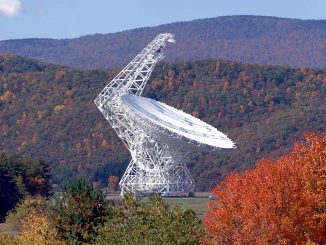
Green Bank Telescope


Breakthrough Listen searches new-found nearby planet Proxima b for signs of ET
Breakthrough Listen, the 10-year, $100-million astronomical search for intelligent life beyond Earth launched in 2015 by Internet entrepreneur Yuri Milner and Stephen Hawking, has just announced its first observations of newly-discovered Earth-size planet Proxima b orbiting the nearest star to the Sun using the Parkes Radio Telescope in New South Wales, Australia.

Breakthrough Listen to search for intelligent life around weird star
Tabby’s star, otherwise known as KIC 8462852, has provoked so much excitement over the past year, with speculation that it hosts a highly advanced civilisation capable of building orbiting megastructures, that UC Berkeley’s Breakthrough Listen project is devoting hours of time on the Green Bank radio telescope to see if it can detect any extraterrestrial signals.

Green Bank Observatory: the making of an American astronomy icon
Astronomers have just celebrated the inauguration of the Green Bank Observatory in West Virginia, home to the 100-metre Green Bank Telescope, one of the world’s most powerful astronomical instruments. During its 60-year history, Green Bank has been home to some of the world’s most innovative and productive radio telescopes.

Earth-space telescope observations of quasar 3C 273’s hot heart
Astronomers using an orbiting radio telescope in conjunction with four ground-based radio telescopes have achieved the highest resolution, or ability to discern fine detail, of any astronomical observation ever made. The researchers were surprised when their Earth-space system revealed a core temperature hotter than 10 trillion degrees for quasar 3C 273.

Asteroid 2003 SD220 sleighs by Earth on Christmas Eve
During the month of December, the Planetary Radar Group at Arecibo Observatory has observed near-Earth asteroid 2003 SD220, which will make its closest approach to Earth on Christmas Eve. Although designated as “potentially hazardous,” this asteroid will be 28 times further away than our Moon and therefore poses no present danger to Earth.

Asteroid looks even better second time around
Asteroid 1998 WT24 safely flew past Earth on 11 December at a distance of about 2.6 million miles (11 lunar distances). During its flyby, NASA scientists used the 230-foot (70-metre) DSS-14 antenna at Goldstone, California, to probe it with microwave transmissions. Using this technique, they created the highest-resolution radar pictures of the asteroid — 2.5 times better than when it was last imaged, 14 years ago.

‘Fast Radio Burst’ sheds new light on origin of these extreme events
Fast radio bursts (FRBs), brief yet brilliant eruptions of cosmic radio waves, have baffled astronomers since they were first reported nearly a decade ago. Though they appear to come from the distant universe, none of these enigmatic events has revealed more than the slimmest details about how and where it formed, until now.

Radar images provide new details on Halloween asteroid
The highest-resolution radar images of 600 metre-wide asteroid 2015 TB145‘s safe flyby of Earth have been processed. NASA scientists used giant, Earth-based radio telescopes to bounce radar signals off the asteroid as it flew past Earth on 31 October at 17:00 UTC (~5pm GMT) at about 1.3 lunar distances (302,500 miles, or 486,800 kilometres) from Earth.

Halloween asteroid’s close fly-by a treat for radar astronomers
NASA scientists are tracking the upcoming Halloween flyby of asteroid 2015 TB145 with several optical observatories and the radar capabilities of the agency’s Deep Space Network at Goldstone, California. Only discovered sixteen days ago, the 400-metre-wide asteroid will fly past Earth at a safe distance slightly farther than the Moon’s orbit on 31 October at 5:05pm GMT.
